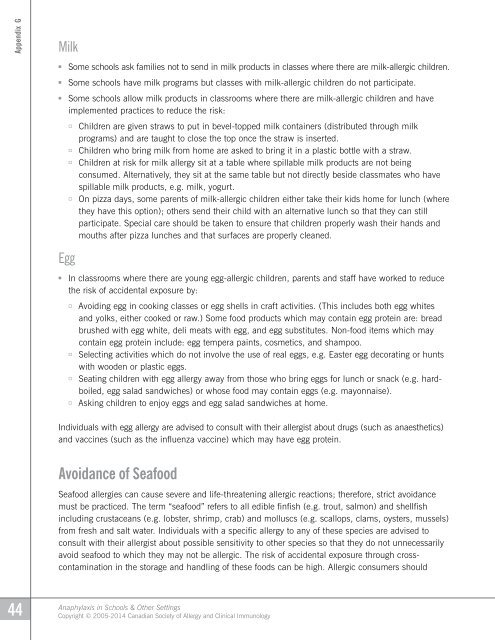Anaphylaxis in Schools 3rd Edition
Anaphylaxis in Schools 3rd Edition
Anaphylaxis in Schools 3rd Edition
Create successful ePaper yourself
Turn your PDF publications into a flip-book with our unique Google optimized e-Paper software.
Appendix G<br />
Milk<br />
• Some schools ask families not to send <strong>in</strong> milk products <strong>in</strong> classes where there are milk-allergic children.<br />
• Some schools have milk programs but classes with milk-allergic children do not participate.<br />
• Some schools allow milk products <strong>in</strong> classrooms where there are milk-allergic children and have<br />
implemented practices to reduce the risk:<br />
<br />
<br />
<br />
<br />
Egg<br />
Children are given straws to put <strong>in</strong> bevel-topped milk conta<strong>in</strong>ers (distributed through milk<br />
programs) and are taught to close the top once the straw is <strong>in</strong>serted.<br />
Children who br<strong>in</strong>g milk from home are asked to br<strong>in</strong>g it <strong>in</strong> a plastic bottle with a straw.<br />
Children at risk for milk allergy sit at a table where spillable milk products are not be<strong>in</strong>g<br />
consumed. Alternatively, they sit at the same table but not directly beside classmates who have<br />
spillable milk products, e.g. milk, yogurt.<br />
On pizza days, some parents of milk-allergic children either take their kids home for lunch (where<br />
they have this option); others send their child with an alternative lunch so that they can still<br />
participate. Special care should be taken to ensure that children properly wash their hands and<br />
mouths after pizza lunches and that surfaces are properly cleaned.<br />
• In classrooms where there are young egg-allergic children, parents and staff have worked to reduce<br />
the risk of accidental exposure by:<br />
<br />
<br />
<br />
<br />
Avoid<strong>in</strong>g egg <strong>in</strong> cook<strong>in</strong>g classes or egg shells <strong>in</strong> craft activities. (This <strong>in</strong>cludes both egg whites<br />
and yolks, either cooked or raw.) Some food products which may conta<strong>in</strong> egg prote<strong>in</strong> are: bread<br />
brushed with egg white, deli meats with egg, and egg substitutes. Non-food items which may<br />
conta<strong>in</strong> egg prote<strong>in</strong> <strong>in</strong>clude: egg tempera pa<strong>in</strong>ts, cosmetics, and shampoo.<br />
Select<strong>in</strong>g activities which do not <strong>in</strong>volve the use of real eggs, e.g. Easter egg decorat<strong>in</strong>g or hunts<br />
with wooden or plastic eggs.<br />
Seat<strong>in</strong>g children with egg allergy away from those who br<strong>in</strong>g eggs for lunch or snack (e.g. hardboiled,<br />
egg salad sandwiches) or whose food may conta<strong>in</strong> eggs (e.g. mayonnaise).<br />
Ask<strong>in</strong>g children to enjoy eggs and egg salad sandwiches at home.<br />
Individuals with egg allergy are advised to consult with their allergist about drugs (such as anaesthetics)<br />
and vacc<strong>in</strong>es (such as the <strong>in</strong>fluenza vacc<strong>in</strong>e) which may have egg prote<strong>in</strong>.<br />
Avoidance of Seafood<br />
Seafood allergies can cause severe and life-threaten<strong>in</strong>g allergic reactions; therefore, strict avoidance<br />
must be practiced. The term “seafood” refers to all edible f<strong>in</strong>fish (e.g. trout, salmon) and shellfish<br />
<strong>in</strong>clud<strong>in</strong>g crustaceans (e.g. lobster, shrimp, crab) and molluscs (e.g. scallops, clams, oysters, mussels)<br />
from fresh and salt water. Individuals with a specific allergy to any of these species are advised to<br />
consult with their allergist about possible sensitivity to other species so that they do not unnecessarily<br />
avoid seafood to which they may not be allergic. The risk of accidental exposure through crosscontam<strong>in</strong>ation<br />
<strong>in</strong> the storage and handl<strong>in</strong>g of these foods can be high. Allergic consumers should<br />
44<br />
<strong>Anaphylaxis</strong> <strong>in</strong> <strong>Schools</strong> & Other Sett<strong>in</strong>gs<br />
Copyright © 2005-2014 Canadian Society of Allergy and Cl<strong>in</strong>ical Immunology


